Research Design
Primary Research
Primary research approach for the study was carried out through questionnaires and focus groups. The questionnaire survey and focus group were designed to obtain an inclusive understanding of the consumer’s approach related to celebrity endorsement. It was deliberated and implemented to understand the basic aim that was to what extent the celebrity endorsement in advertising is influencing the consumer behavior.
In today’s world celebrities acts as representatives, in order to support and advertise brands, products and ideas. Therefore, the primary research clarified the fact that whether or not celebrity endorsement is more effectual than non celebrity endorsement. Furthermore, with the help of this survey it also highlighted that to what extend identified theories in celebrity endorsement explains and reflects consumer behavior. The purpose of this research was to study the factors affecting consumers while purchasing products, and to find out the intensity of being endorsed by the celebrity related advertisements.
It is imperative to realize that most of the questions in the survey questionnaire were designed in such a manner that the answer structures were closed ended. On the other hand, open ended questions were also provided to the focus groups. The purposes of maintaining the closed ended answer structure was to facilitate in the processing and subsequent analysis of the findings. The answer scale was designed to function in a multiple choice format for the respondents. Where as in focus groups, open ended questions were created which made it easier and feasible for the respondents to share their viewpoints by elaborating and explaining with examples.
Sampling
The survey questionnaires were constructed to collect information from a potentially huge number of respondents. Questionnaires are the only reasonable way to achieve a number of assessors large enough to allocate statistically analysis of the results. The questionnaires were conducted by a total of 350 respondents. Young men and women aged between 16-25 years were asked to fill out the close ended questions of the survey.
Only school and college students were targeted, as they are the vital consumers who are highly influenced by celebrities and advertisement messages. The main goal of this research was to address the main aspects of celebrity endorsement in advertisements. Question 6 and 8 were the most critical questions in the survey, as it emphasized upon the persuasiveness of messages being conveyed through advertisements. Whereas, in question 8 it highlighted the effectiveness of celebrity endorsed advertisement and non celebrity endorsed advertisements.
On the other hand, focus groups were also conducted. Focus group comes under the category of qualitative research. These focus groups were carried out to understand people’s ideas, beliefs, thoughts and perceptions towards advertisements, medium channels and celebrity endorsement. Four focus groups were carried out with a group of 8 participants in each focus group interview. The composition of the four focus groups was as follows: High-school Boys ages 16-19, High-school Girls ages 16-19, College going boys age 20-25, and college going girls age 20-25.
Secondary Data
The secondary research for the study was carried out through the assistance of the journal articles, various books and websites. The approach and its key variables as explored in the literature review served to highlight a variety of areas that merited investigation and analysis. As a result, the secondary research for this study is one that brings together the analysis as well as the required data that helped to understand aims and objectives of the report.
Limitations
Traditional research approaches call for the identification of limitations during the concluding stages of the research. However, modern day research designs make it next to mandatory to carry out an analysis of potential research limitations at earlier stages in the research in order to avoid letting the data collection, handling, and analysis procedures from getting compromised.
In the perspective of the current study, it is imperative to note that the current study is making extensive use of primary data which is being collected by the survey questionnaire approach and focus groups approach. The survey questionnaire is an approach that is often used for the purpose of primary data collection; however it is not one without its potential limitations. The survey questionnaire approach places an extensive degree of reliance on the ability of the researcher to appropriately word the questions and the answer structure.
Any inappropriate expression in the question statement can lead the respondent to misinterpret the question and provide the research with inaccurate data. This inaccurate data then comes as a threat to the authenticity and validity of the findings of the entire research. A similar limitation exists in the case of the answer structures. Inappropriate answer structures can restrict the respondents’ ability to adequately answer the questions; and may lead the respondent to provide responses other than those which he/she wishes to provide.
The second integral component of this research is that which lies in the secondary data. The secondary data is mainly making use of peer reviewed publications and former researches. In this regard, the potential limitation lies in the fact that certain unforeseen limitations may have existed in the scenarios of the former researches. If any foresight at that time led the limitations to jeopardize the findings of those studies, then the use of those findings may serve to passively jeopardize the findings of the current research.
As a result, special care was taken in the selection and subsequent usage of former researches and peer reviewed publications. Each study was carefully observed to note if it had given regard to potential limitations at the time of its execution and only those researches were selected and used that were recent and authentic in their findings.
Analysis and Findings
Findings of Questionnaire Survey
Respondents were asked to answer twelve questions, and the result was gathered based upon their perceptions. This questionnaire survey observes whether consumers conclude that they like the products and brands that are being supported by the celebrity endorsers, and presents a tables and figures using these implications and other characteristics of the survey to foresee feelings and thoughts toward the endorsed product.
Participants who conducted these questionnaires were asked to conclude the extent to which the respondents truly get attracted to advertised product and to rate the endorser’s pleasant appearance, resemblance to themselves, and knowledge of the product. Attitudes toward the commercials, the endorser and the product were also considered. The resulting analysis specified that product buying decisions were calculated by implications about the endorser’s demands for the product and by attitudes toward the end-users.
Attention to an Advertisement
The survey questionnaire began by pointing the importance of advertisement. In the first question the respondents were asked that whether they pay attention to advertisements or not. This approach was followed as advertisements are the leading elements of promotion that is used to enlighten, influence, attract and remind the consumers about the products, brands and services (Busler 2002). In response to this question designed, it was observed that 88.3 percent of the respondents paid attention to advertisements whereas, 11.7 percent of them do pay attention.
Table 1: Attention to an Advertisement.
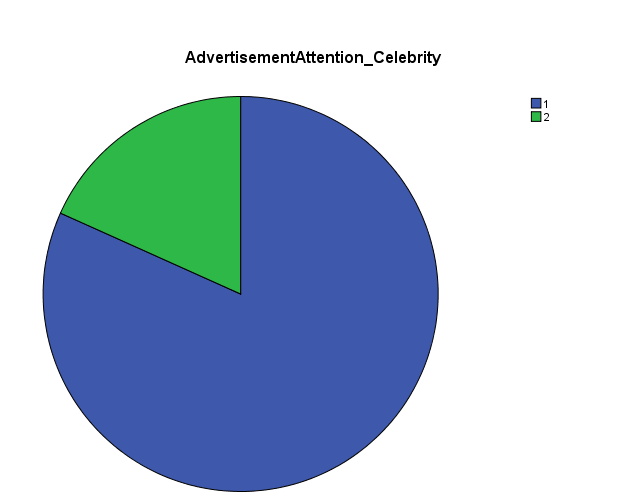
Attention to a Celebrity Based Advertisement
The next question was sought to inquire how many people pay more attention to celebrity based advertisement as compared to people acknowledging those advertisements that does not have celebrity feature. In today’s world celebrity endorsement has amplified, and it has grown into a prevalent advertising approach. These famous personalities and celebrities work as representatives to promote and market the products and ideas (Jansson and Simonsson 2006). The results of the survey also clarify the fact that people are getting more attracted to advertisements that have celebrities in it, as 81.7 percent of the respondents said yes while the remaining 18.3 percent said they do not prefer celebrity featured advertisements.
Table 2: Attention to a Celebrity Based Advertisement.
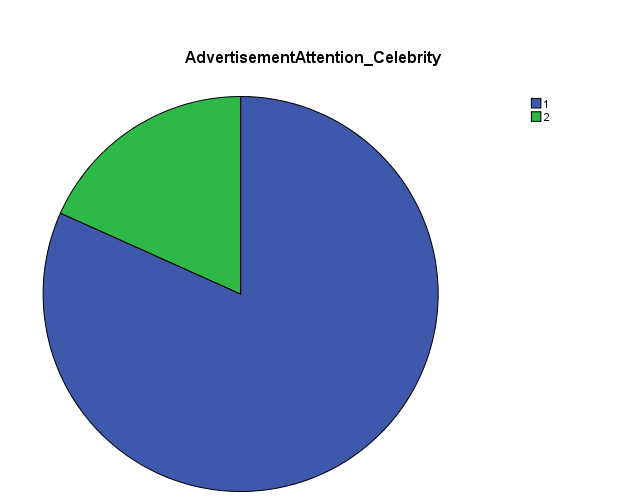
Easier to Recall to a Celebrity Based Advertisement
The third question emphasizes upon a highly imperative aspect i.e. whether it is easier to recall advertisements if it featured a famous personality as compared to advertisements that do not has celebrities in it. According to one research celebrities create advertisements realistic, improve message and easier to recall (Solomon 2002). In addition, when celebrities are renowned and recalled by brand names, it develops an encouraging approach towards the brand and the company. The following finding shows that 84.3 percent of young adults are in favor celebrity based advertisements, as according to them those advertisements are easier to recall. On the other hand, 15.7 percent said that advertisements featuring celebrities are not easier to recall.
Table 3: Easier to Recall to a Celebrity Based Advertisement.
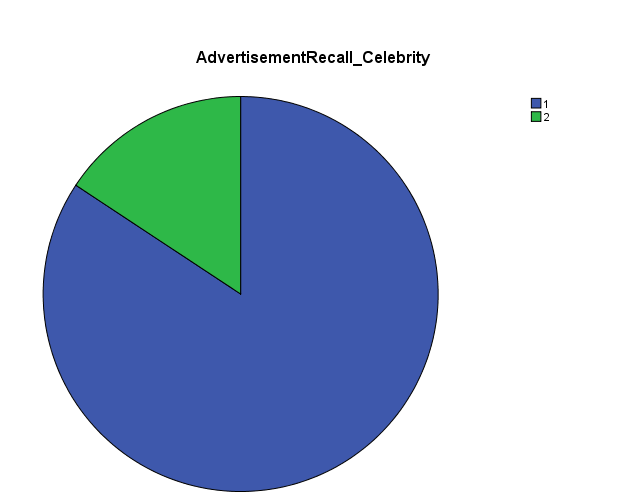
Most Frequent viewed Medium of Advertisement
This question was designed to analyze the medium of advertisement that is being mostly viewed and appreciated by the public. There are various mediums in which advertisements are positioned including television, newspapers, magazines, internet and outdoor advertisements.
TV Commercials
The result demonstrates that T.V commercials are most frequently watched as compared other mediums of advertisement. The targeted respondents are young men and women who mostly get inspired by television ads, as 54.3 percent choose to watch T.V. commercials.
Table 4.1: Most Frequent viewed Medium of Advertisement (TV Commercials).

Printed Advertisements
Printed Advertisements include magazines, newspapers, yellow pages and business publications. Teenagers and college going students do not pay much attention to printed advertisements, as they spent their free time watching T.V or surfing Internet. Therefore, only 4.6 percent of respondents preferred print medium to be most frequently viewed means of advertisement. Whereas, 49.1% stated that printed advertisements are not attractive and they do not pay attention to advertisements that are presented in newspapers, yellow pages and magazines.
Table 4.1: Most Frequent viewed Medium of Advertisement (Printed Advertisements).
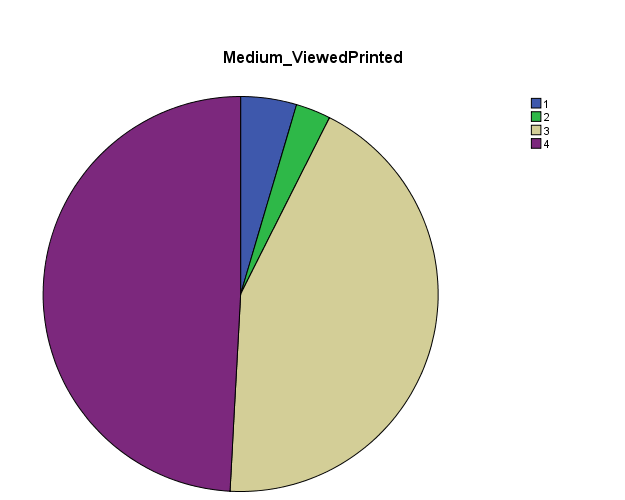
Internet
Today, Internet has become one of the leading sources of advertisements. The introduction of Internet has made advertising on the World Wide Web highly renowned. Numerous organizations, companies and business are taking benefits from the Internet. With the enhancement in technology, special effects are being carried out to create advertisement more appealing. Vibrant colors, superior page layout and loads of imagination are attracting the consumers. The responses serve to prove that 23.4 percent and 34.3 percent of respondents choose Internet to be one of the best medium for advertisements.
Table 4.1: Most Frequent viewed Medium of Advertisement (Internet).
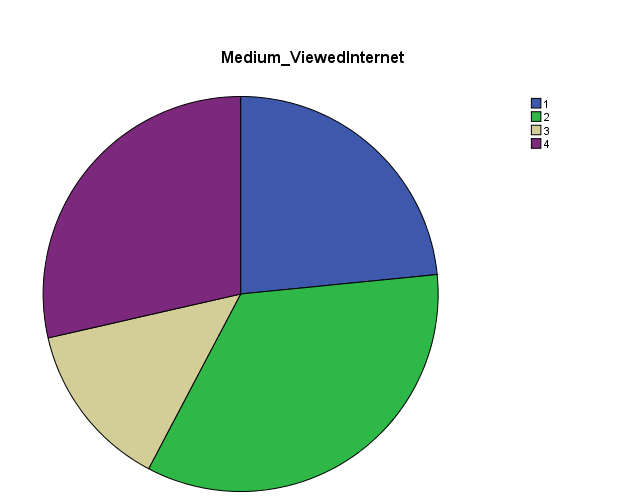
Outdoor Advertisements
Outdoor advertisement is one of the extremely essential types of advertising in today’s world. Just as other mediums are necessary, outdoor advertising also encourages businesses and construct images. It plays a highly vital role in making a brand or a product successful. However, by considering the results of survey it inquires that the young generation pays more attention to other means of advertising as compared to outdoor advertisements.
Table 4.1: Most Frequent viewed Medium of Advertisement (Outdoor Advertisements).
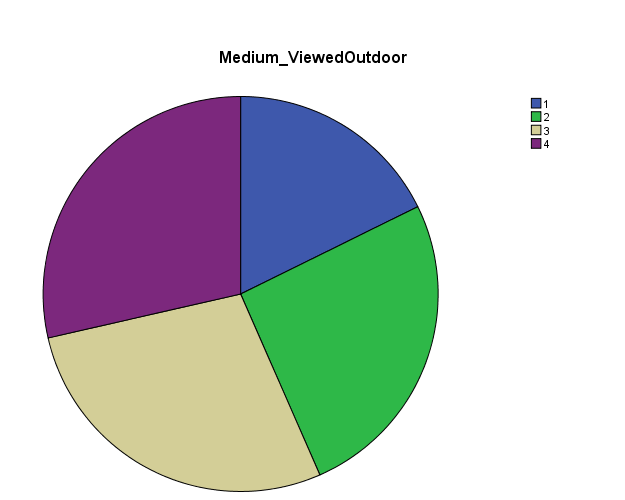
Medium affecting the Advertisement Message
The response of this question assisted to understand the effectiveness of medium for the messages given in advertisements. The result proved that the mediums of advertisement are playing a major role in promoting the products and ideas, as eighty-nine percent said yes in the response, while the remaining 10.9 percent showed a negative feedback to the question.
Table 5: Medium affecting the Advertisement Message.
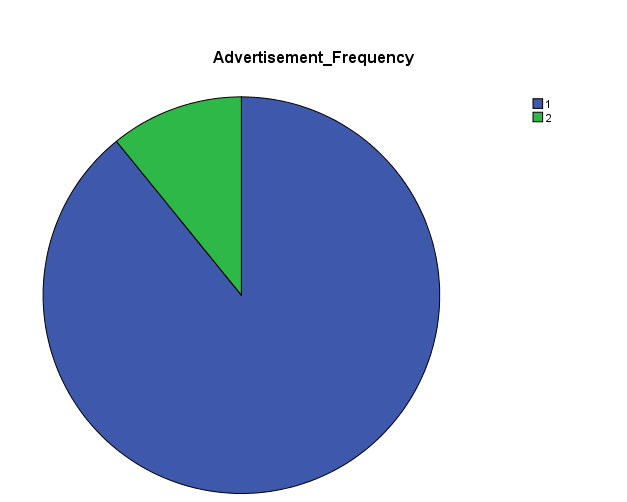
Frequency of Exposure to Advertisements increasing Persuasiveness
This is one of the most crucial questions of the survey. It was designed to identify degree of persuasiveness created into the consumer’s mind with the help advertisements. The results shows that age does not restrained this effect, younger and older children both get attracted by commercials. They want to buy the product as they once see on the advertising mediums. It clarifies that 62.9 percent agree and 30.9 percent strongly agree that the frequency of exposure to advertisements increase persuasiveness of the message that is being communicated; whereas, only 6-7 percent disagree with this aspect of increased persuasiveness.
Table 6: Frequency of Exposure to Advertisements increasing Persuasiveness.
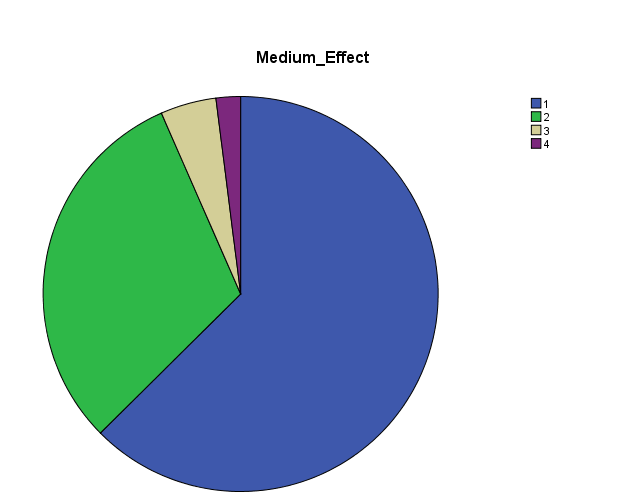
Advertisement influencing Buying Decision
According to Ashwini (2009), “Advertisements aim to influence the way consumers view themselves and how buying certain products can prove to be beneficial for them. The message conveyed through advertising appeals influences the purchasing decisions of consumers.” Advertisement uses influencing techniques to persuade and convince people to purchase certain products. Advertising appeals are planned in a manner so as to build a positive image of the persons who use specific products.
Advertising organizations and companies use different types of advertising techniques to manipulate the buying decisions of consumers (Ambekar 2009). The survey analysis shows that 61.1 percent of the respondents are highly influenced and 28.9 percent are partially influenced by the advertisements in their buying decisions. While only 7.4 percent says that their buying decisions are not based upon advertisements.
Table 7: Advertisement influencing Buying Decision.
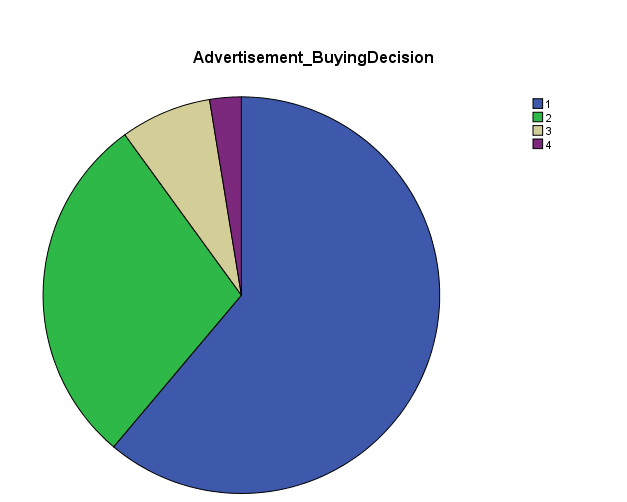
Comparison of Celebrity Endorsement and Non Celebrity Endorsement
These days celebrity endorsement is applied in almost every advertisement. People prefer to watch celebrity based advertisements as in contrast to non-celebrity based. The response also states that 42.9 percent strongly agree to this approach whereas, 53.4 percent agree to this concept.
In contrast almost 4 percent of the respondents disagreed with this fact which might be because there are no differences in the respondent’s aptitude to relate celebrities with the products they endorse and no noticeable distinction in celebrity persuade on their buying behaviors. “However, celebrity endorsers can create more positive responses towards advertising and greater purchases intentions than a non-celebrity endorser. The advertising agencies will have to build an association with a desired celebrity, which will create a necessary consumer pull” (Jansson and Simonsson 2006).
Table 8: Comparison of Celebrity Endorsement and Non Celebrity Endorsement.
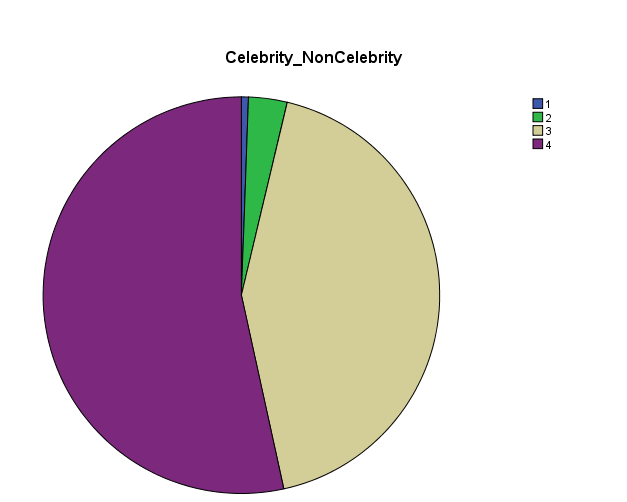
Celebrity Creditability for Multiple Brands
The response to this question shows that 62.9 percent of the participants believe that if the celebrity endorses multiple brands or product it highly influence the creditability of the celebrity. In contrast 2.6 percent of the respondents are not aware of this fact, and only 3.1 percent thinks that it does not really influence their perception if the celebrity is endorsing one or multiple brands or products at the same time.
Table 9: Celebrity Creditability for Multiple Brands.
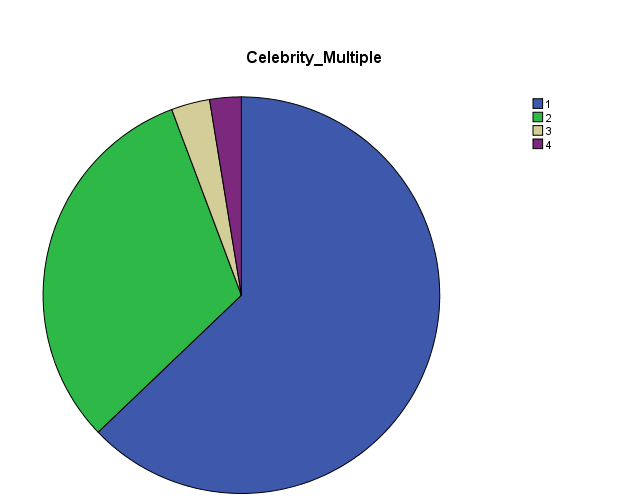
The Perceived Credibility of Celebrity affects the Creditability of Brand/Product
Michael Jordan, Brad Pitt, Tiger Woods, David Beckham, Günther Jauch, Britney Spears, Cortney Cox they have all something in common. They are popular due to their public emergence and accomplishments in television, games, magazines etc. Furthermore, all of them are marketing or endorsing products. The use of famous spokesperson or celebrities in marketing communications is expanding throughout the world. The analysis proves that perceived credibility of celebrity affects the creditability of brand/product that the celebrity endorses because 48.9 percent shows total agreement to this fact and 39.4 percent agree to this perception.
Table 10: the Perceived Credibility of Celebrity affects the Creditability of Brand/Product.
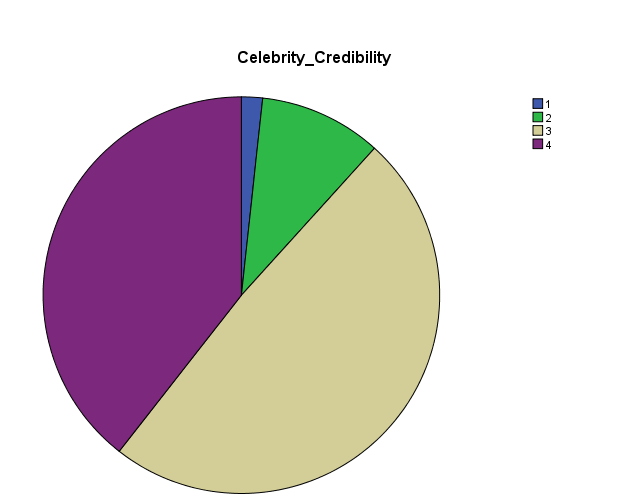
Increasing Persuasiveness by the Physical Attractiveness of the Celebrity
This question was designed to inquire that to what extent the physical attractiveness of the celebrity in a certain commercial increases the persuasiveness of the consumer. The physical appearance and outlook of the celebrity is a highly imperative feature that should never be ignored by the companies and promotional managers. The results also states that almost 90 percent of the respondents strongly agree to this reality. While on the other hand only 5.7 percent disagree and 2.9 strongly disagree with this aspect. Although that would be considered a minor percentage.
Table 11: Increasing Persuasiveness by the Physical Attractiveness of the Celebrity.
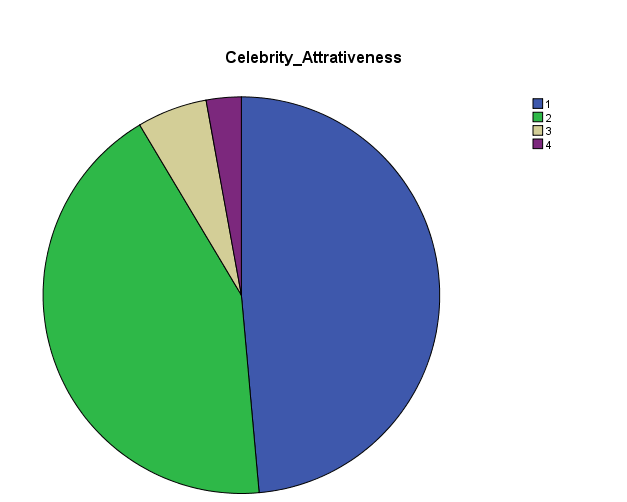
Likability towards a Celebrity Influencing Persuasiveness in Advertisements
Studies disclose that, “Using of attractive celebrity causes to increase attitude towards advertisements. Such attitudes towards advertisements are defined as mental states which are used by individuals to organize the way they perceive their environment and control the way they respond to it” (Ranjbarian and Momeni 2010). There is a substantial correspondence between pleasing attitudes with regard to advertising and evaluating of specific advertisements by respondents as being likeable, agreeable, delightful or disagreeable.
Table 12: Likability towards a Celebrity Influencing Persuasiveness in Advertisements.
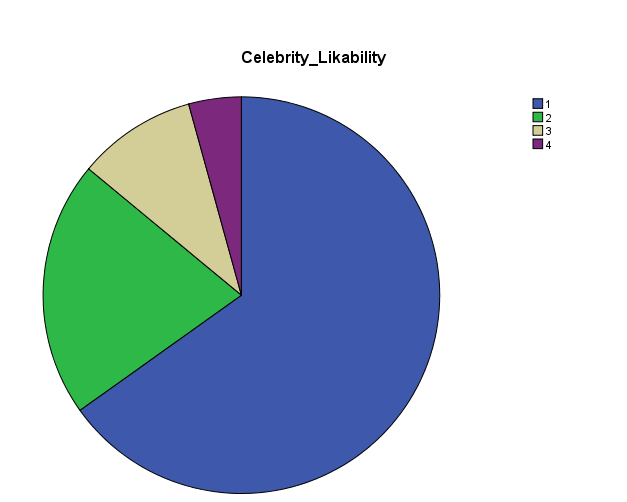
Descriptive Questions
Advertisements affecting your Purchasing Decisions
The first question asked in every focus group was how advertisements affect the purchasing decisions of the consumer. The first focus group was conducted between the high school boys, and most of them believed that they were able to recall advertisements whenever they were browsing through different products at a store. On the other hand, the girls said that they are highly impressed by the advertisements especially the cosmetic commercials and ads.
They mostly purchase cosmetics that are advertised the most because they perceive that advertised cosmetic brands provide the best quality. According to the participants the food and beverages industry and the mobile phone industry provides the most influencing advertisements that highly attracts them to buy or at least try that product for sure. This question helped to observe the customer satisfaction, measure effective communication and importance of advertisements in the people’s minds.
Influence of Celebrity Endorsement in Advertisements
The second question was based on the effect of celebrity endorsement. From the results we came out to know from the high school boys and girls, in case of celebrity endorsed ads, is that the attitude towards buying is experiential hierarchal (from the ABC model of attitudes). This means consumer reacts in emotional basis, so the celebrity that is shown in the ad is their favorite then they will tend to buy the product. According to the other group participants star power really works as they symbolize certain social classes and status. On our close observation towards the answers we found out that consumers are brand conscious, and the one reason for being this is star power. As one of the respondents replied that, “I am the biggest fan of David Beckham and I use Gillette brand juts because of him.”
Easier to Recall to a Celebrity Based Advertisement
The last question was related to the aspect that whether it easier to recall an advertisement if it featured with celebrity in comparison to advertisement that does not has celebrity feature in it. Majority of the participants are highly endorsed by the celebrity based advertisements. Most of the participants pointed out to the “Got Milk Ad” that featured Rihanna the famous singer and Hillary Duff the Hollywood actress in its advertisements. They always recall this ad by these two famous superstars. Majority of the girls pointed out to Eva Longoria, Jennifer Lopez and Elizabeth Banks for the L’Oreal advertisements.
The results of the focus groups specify that celebrity endorsement helps to built positive image of the products and brands. According to one scholar “Celebrity endorser is an individual who enjoys public recognition and who uses this recognition on behalf of a consumer good by appearing with it in an advertisement.” (Jansson and Simonsson 2006).
List of References
Ambekar, Ahswini. Different Types of Advertising Appeals. 2009. Web.
Busler, Michael. Product Differentiation, Celebrity Endorsements and the Consumer’s Perception of Quality. 2002. Web.
Jansson, Johanna, and Regina Simonsson. The subject of celebrity endorsement: what it was and what it has become now. 2006. Web.
Ranjbarian, Bahram, and Zahra Momeni. Celebrity Endorser influence on attitude towards advertisements and brands. 2010. Web.
Appendices 1
Questionnaire
- Do you pay attention to advertisements? Please tick as appropriate (Yes as 1 and No as 0)
- 1
- 0
- Will you pay more attention to advertisements that is featured with celebrity in comparison to those advertisements that does not have celebrity feature in? Please tick as appropriate (Yes as 1 and No as 0)
- 1
- 0
- Do you find it easier to recall an advertisement if it featured with celebrity in comparison to advertisement that does not has celebrity feature in? (Yes as 1 and No as 0)
- 1
- 0
- Please rank your most frequent viewed medium for advertisements: 1 as most frequent, 4 as least frequent. Places the number 1-4 according to your preference
- TV commercials
- 1
- 2
- 3
- 4
- Printed advertisements (i.e. magazines, newspaper) (1 as most frequent, 4 as least frequent)
- 1
- 2
- 3
- 4
- Internet (1 as most frequent, 4 as least frequent)
- 1
- 2
- 3
- 4
- Outdoor advertisements (1 as most frequent, 4 as least frequent)
- 1
- 2
- 3
- 4
- Does medium affects the message of advertisements? Please tick as appropriate (Yes as 1 and No as 0)
- 1
- 0
- To what extent do you agree the frequency of exposure to advertisements increase persuasiveness of the message that is being communicated? Please tick as appropriate (1 as agree, 2 as strongly agree, 3 as disagree and 4 as strongly disagree)
- 1
- 2
- 3
- 4
- Will advertisements influence your desire to buy a particular product? Please tick as appropriate (1 as not aware of, 2 as not influential at all, 3 as partly influential, and 4 as very influential)
- 1
- 2
- 3
- 4
- To what extent do you agree celebrity endorsement advertisement is more effective than non-celebrity endorsement advertisement? Please tick as appropriate (1 as agree, 2 as strongly agree, 3 as disagree and 4 as strongly disagree)
- 1
- 2
- 3
- 4
- Does it influence your perception of a celebrity’s creditability if the celebrity endorses multiple brands or product? (1 as not aware of, 2 as not influential at all, 3 as partly influential, and 4 as very influential)
- 1
- 2
- 3
- 4
- To what extent do you agree the perceived credibility of celebrity affects the creditability of brand/product that the celebrity endorses? Please tick as appropriate (1 as agree, 2 as strongly agree, 3 as disagree and 4 as strongly disagree)
- 1
- 2
- 3
- 4
- To what extent do you agree physical attractiveness of the celebrity that is featured in advertisement increases persuasiveness of the advertising message? Please tick as appropriate (1 as agree, 2 as strongly agree, 3 as disagree and 4 as strongly disagree)
- 1
- 2
- 3
- 4
- To what extent do you agree likability towards a celebrity that is featured in advertisement influences persuasiveness of the advertising message? Please tick as appropriate (1 as agree, 2 as strongly agree, 3 as disagree and 4 as strongly disagree)
- 1
- 2
- 3
- 4
Appendices 2
Questions for Focus Groups
- To what extent advertisements affect your purchasing decisions?
- Does celebrity endorsement in advertisement influence you? If yes then to what extent?
- Do you find it easier to recall an advertisement if it featured with celebrity in comparison to advertisement that does not has celebrity feature in? If yes then please explain in detail with one of your live example.